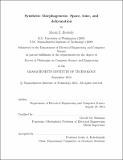| dc.contributor.advisor | Gerald Jay Sussman. | en_US |
| dc.contributor.author | Brodsky, Micah Z. (Micah Zev) | en_US |
| dc.contributor.other | Massachusetts Institute of Technology. Department of Electrical Engineering and Computer Science. | en_US |
| dc.date.accessioned | 2015-01-20T15:30:18Z | |
| dc.date.available | 2015-01-20T15:30:18Z | |
| dc.date.copyright | 2014 | en_US |
| dc.date.issued | 2014 | en_US |
| dc.identifier.uri | http://hdl.handle.net/1721.1/92963 | |
| dc.description | Thesis: Ph. D., Massachusetts Institute of Technology, Department of Electrical Engineering and Computer Science, 2014. | en_US |
| dc.description | This electronic version was submitted by the student author. The certified thesis is available in the Institute Archives and Special Collections. | en_US |
| dc.description | Cataloged from student-submitted PDF version of thesis. | en_US |
| dc.description | Includes bibliographical references (pages 127-133). | en_US |
| dc.description.abstract | Synthetic biology has presented engineers with a fascinating opportunity: can we understand the principles of our origins { animal embryonic development - by re-engineering it in the laboratory? I investigate, from an engineer's perspective, some of problems that arise in developing geometric form in a deformable substrate. More abstractly, I attack the problem of establishing spatial patterns, when rearranging and deforming parts of the system is inherent to the process. Deformable, foam-like cellular surfaces are developed as a model for embryonic epithelia (polarized cellular sheets), one of the principal tissue types in early animal development. I explore ways in which simple agent programs running within the individual cells can collectively craft large-scale structures. The mechanical properties of the substrate prove crucial to the patterning process. In such a distributed, heterogeneous substrate, little can be assumed about the progress of time. In one branch of my work, I develop patterning techniques where convergence is transparently and locally detectable, drawing insights from clockless digital circuits and casting the problem as distributed constraint propagation. In another branch of work, I avoid the problem of timing by making all patterns self- correcting. In self-correcting patterning, I attempt to understand "canalization" - how development is naturally robust to perturbations. I formulate a model for regional patterning, inspired by regeneration experiments in developmental biology, and using mathematical principles from classical models of magnetic domains and phase separation. The problem again becomes a form of distributed constraint propagation, now using soft constraints. I explore some of the resulting phenomena and then apply the mechanism to crafting surface geometries, where self-correction makes the process robust to both damage and self-deformation. I conclude with a look at how this naturally leads to an example of partial redundancy { multiple systems that partly but not completely overlap in function - yielding confusing responses to the effects of virtual knock-out experiments, reminiscent of the confusing behavior of knock-out experiments in biology. | en_US |
| dc.description.statementofresponsibility | by Micah Z. Brodsky. | en_US |
| dc.format.extent | 133 pages | en_US |
| dc.language.iso | eng | en_US |
| dc.publisher | Massachusetts Institute of Technology | en_US |
| dc.rights | M.I.T. theses are protected by copyright. They may be viewed from this source for any purpose, but reproduction or distribution in any format is prohibited without written permission. See provided URL for inquiries about permission. | en_US |
| dc.rights.uri | http://dspace.mit.edu/handle/1721.1/7582 | en_US |
| dc.subject | Electrical Engineering and Computer Science. | en_US |
| dc.title | Synthetic morphogenesis : space, time, and deformation | en_US |
| dc.type | Thesis | en_US |
| dc.description.degree | Ph. D. | en_US |
| dc.contributor.department | Massachusetts Institute of Technology. Department of Electrical Engineering and Computer Science | |
| dc.identifier.oclc | 899985465 | en_US |
